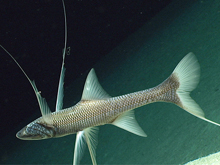Deep-water Connections:
Octocorals at the Southern Distribution Limits
March 13 – 31, 2009

Close-up of a tripod fish at 1,960 meters (6,430 foot) depth in the Northeast Providence Channel near Eleuthera Island. Click image for larger view and image credit.
Think of the word "corals." What images come to mind? If you are like most people, you envision vivid, colorful mounds of impressive brain and staghorn corals: the kind of corals that make up tropical, shallow-water reefs like the Great Barrier Reef. But what about corals in the deep? There are corals that live in much deeper, colder waters — where there is no sunlight — and that's what this mission is about.
From March 13 to 31, the Deep-water Connections science team will explore the deep slopes of the Northern Bahamas, looking for deep-sea communities of octocorals (commonly referred to as soft corals, gorgonians, or sea fans). The expedition, led by Chief Scientist Scott C. France, is a continuation of earlier investigations. For the past eight years, France and colleagues from the University of Louisiana – Lafayette have studied deep-sea corals in North Atlantic waters between 1,000 and 2,500 meter (3,280 and 8.202 foot) depths, including a previously unexplored group of extinct underwater volcanoes.
Those explorations revealed some spectacular assemblages of bamboo corals, bubblegum corals, black corals, and a variety of other sea fan and sea whip species. Living with the corals were myriad animals, including shrimp, crabs, snake stars, sea stars, feather stars, scale worms, and many species of deep-sea fish. Most of the species found were new to science.
During Deep-Water Connections, the investigators plan to follow up by studying octocorals at the southern distribution limits. Octocorals most often are found attached to a hard-bottom substrate so the science party will explore the deep slopes of the northern Bahamas. They will use the remotely operated vehicle (ROV) Global Explorer ![]()
![]() , which is equipped with a high definition video camera and robotic arm, and is piloted from the deck of the research vessel R/V F.G. Walton Smith
, which is equipped with a high definition video camera and robotic arm, and is piloted from the deck of the research vessel R/V F.G. Walton Smith ![]()
![]() . Their goal is to determine if the coral species and their associate fauna living in the subtropical Bahamas are the same as those on the seamounts to the north, or will they begin to see a different group of species reflecting a southern influence?
. Their goal is to determine if the coral species and their associate fauna living in the subtropical Bahamas are the same as those on the seamounts to the north, or will they begin to see a different group of species reflecting a southern influence?
After studying bathymetric maps of the region (see map figure), the researchers have identified three major areas of interest: the mouth of Little Abaco Canyon (north of Abaco Island), the Bahama Escarpment (the steep-walled drop-off from the Bahama Plateau into the North Atlantic Basin), and the San Salvador spur (an underwater feature that juts northward from the Bahama Plateau). Biological communities in these deep-sea areas have never before been explored using modern imaging technologies, such as the high-definition video we will collect on this exciting mission.



